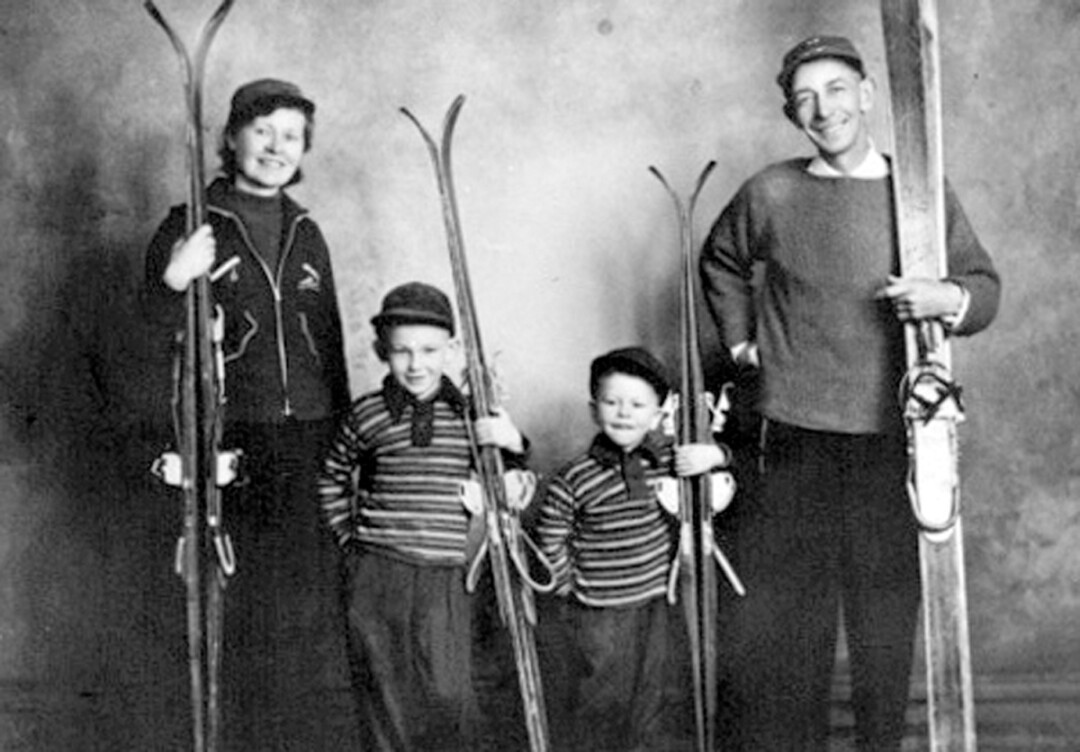Adolph Peterson: Jumping Skis, and the Development of Gallatin Valley Skiing
Rachel Phillips | Thursday Dec. 1st, 2016

Adolf Pedersen was born in Lillehammer, Norway on November 15, 1900. He and his family immigrated in 1915, joining his uncle who had immigrated in 1911. At Ellis Island, immigration officials wrote “Adolph Peterson,” after hearing his name. Being only 15 (and knowing no English) he shrugged and kept that spelling the rest of his life.
To support himself and his mother (who also knew no English) he worked on his uncle’s homestead and farm and learned the language by reading newspapers and talking with his uncle. His mother never did learn much English and depended on him for much of her life.
Coming to the United States was not only the end of his formal education but also the end, until he was 32, of practicing the sport he loved and excelled at in Norway: ski jumping. In 1914, a ski factory had been built in Lillehammer. Wanting to make the opening a celebratory event, they decided that the first pair of skis made would be awarded to the best junior jumper in town—Adolf.
Adolph bought his own farm near Minot, North Dakota, when he was just 19, and farmed it successfully until the dust bowl and recession drove him into bankruptcy. He found his true love in Florence Luidahl, and they were married in 1935. In 1937, a local ski club was formed and a ski jump was built on the banks of the river in Minot. He started jumping again and entered local competitions. The next year he entered competitions in Montana—Anaconda, Butte, and at Karst Ranch in Gallatin Canyon.
At the same time that Minot established their ski club in 1937, the Bozeman Ski Club formed in the Gallatin Valley. The group’s first major event was a ski jumping exhibition held at Karst Ranch (a dude ranch in Gallatin Canyon) on January 31, 1937. Great crowds lined the slope to watch athletes like Adolph Peterson perform impressive jumps. Spectators needed warming up after a day in the snow, and Karst’s bar catered to patrons who could relax with their feet placed in the bindings of broken skis fixed to the floor.

During his second trip to Karst Ranch in 1939, Adolph wrote a letter home to his wife, saying that since it was obvious they were going to lose the farm, the Bozeman area would be a great place to raise their family. So began their residence in Bozeman, with their two sons Adolph Jr. (born March 3, 1937) and Reider (born May 17, 1939). Taking note that there was no place for he and his family (and others who might be interested) to ski, he embarked on a plan to build a ski area.
The Story Hills had good terrain and was close to town and Peterson rented some land for $5.00 from Malcolm Story to build what was called Pine Hill. Located west of the fish hatchery, Pine Hill provided the first opportunity for local ski lessons, and Peterson passed on his knowledge to area children. Pine Hill went into operation in 1942 and included a jumping hill off to one side of the downhill slopes.
Ingeniously, Adolph constructed the first rope tow out of an old Cadillac’s motor. According to Ray Pratt, a frequent visitor to Pine Hill during those early years, “Not only did he [Peterson] charge no fee, he even served us refreshments.” At the same time Peterson was sparking an interest in skiing in the Gallatin Valley, he continued competing in ski jumping meets across the country. Adolph finished in 3rd place in the “veterans” class of a national ski jumping championship held at Snoqualamie Pass in Washington in 1941. He also won the “The Western States Championships” in Sun Valley, Idaho. Because he won the jumping event, he got to sit at the head table at the awards banquet with the likes of Sonja Henie (figure skater and film star) and actor Gary Cooper, a Montana native. That was when Sun Valley was “the place” to go for skiing by the Hollywood stars.
Eventually, the Bozeman Ski Club decided that a larger ski area than Pine Hill was needed for the growing interest in the sport. When the Bear Canyon site was selected, Adolph’s rope tow was moved to the new area. One advantage of moving the downhill area to Bear Canyon was that there were larger hills on which to build new ski jumps. Two jumps were built—a 45-meter and a 60-meter—up nearby New World Gulch, and were used for high school and college competitions. Races were popular, and Montana State College Fraternities held a ski race at Bear Canyon in 1938.
Besides Adolph Peterson, a number of other individuals contributed to the growth of skiing and ski jumping in the Gallatin Valley, including Dean Hauseman, August “Gus” Gnehm, the Livers family, Dave and Chris Kundert, and Gib and Kay Widmer. Kay Widmer was well-known for her column in the Bozeman Daily Chronicle, titled “Dope on the Slope,” which highlighted local ski news—everything from ski hill courtesy to wipeouts. Kay reported weekly on ski topics like the ones below:
November 21, 1944
Hill Statistics
For your information, a recent survey of the Bear Canyon hill revealed that in a distance of 1600 feet, the tow lifts you to an elevation of 550 feet. The downhill racing trail extends back 1000 feet further, to a point 300 feet higher, making a total of 850 feet in a half mile. Pretty steep, but it still doesn’t rate as a Class A hill. Just give us time and axes.
February 13, 1945
Proud Papa
Adolph Peterson was just as proud as his two sons when they both copped first prizes in their classes. Said Adolph: “I’m getting more of a kick out of this than if I were racing myself.”

In her paper titled Skiing—As I Remember It, Kay Widmer remembered early skiing clothing and equipment: “Ski boots were unheard of—snow boots were good enough. Our first ski pants were heavy woolen things designed more for warmth than style and they had a propensity for collecting snow and dampness with every tumble. Poplin jackets were “in,” but they had to be large enough to accommodate the layers of sweaters a skier wore underneath. We were hardly the streamlined athlete you see on the slopes today.”
During World War II, local residents had their first taste of night skiing at Bear Canyon. Flares were positioned along the slopes, which provided an exhilarating experience of skiing through patches of light and complete darkness. Widmer related one hazard of skiing in the dark: “one night Jimmy Livers and Sandy McCracken collided on the dark side of a flare and knocked each other out. They lay unconscious in the snow for some time before someone else skied into them.”
In 1947, Adolph and Florence Peterson bought some land on South Church Street to build their home. When the excavation for the lower level was being done, Adolph had workers take the bulldozer partway up the hill and push some dirt out to form a landing for a ski jump. Adolph Jr., Reider, and many local kids learned to ski jump on that little 20-meter hill. During the winter, most after school hours would find up to 8 kids jumping until it became too dark to see, with Adolph coaching them as they carried their skis up the hill for another ride. Cars would park on the shoulder for a while to watch the action.
Eventually, the Petersons started a confection wholesaling business in Yellowstone Park. First they ran it out of Bozeman, but their operation grew and in 1954 they bought 80 acres west of West Yellowstone from which to run it. In 1960, the Biathlon (cross country-skiing and rifle shooting) became an Olympic event. The American team tryouts were to be held in Bozeman but it was a year with very low snow. Organizers scrambled to find an alternate site. Because he was well known in the ski world, Adolph got a call asking if he knew of any place suitable for the tryouts in the West Yellowstone area. “Well,” he said “my land is pretty flat, abuts Forest Service land if you need more distance, and there is an embankment that would work for the shooting range.” He also offered the use of a building for waxing skis, etc. After looking over the site, committee members agreed that it would be a great place for their event, and the first Olympic tryouts for the U.S. Biathlon team were held on Adolph’s land.
In July 2016, Adolph Peterson’s son Reider Peterson generously donated his father’s jumping skis to the Gallatin History Museum. A photograph of Adolph’s jumping skies appears on pages 24-25. Rachel Phillips is the Research Coordinator at the Gallatin History Museum in Bozeman.
Sources:
Kay Widmer, “Skiing—As I Remember It.” Typed paper, page 2.
Stan Cohen, Downhill in Montana: Early Day Skiing in the Treasure State and Yellowstone National Park, A Pictorial History, Pictorial Histories Publishing Company, Inc., Missoula, MT, 2007, p. 227.
Edna Berg and Annie Cicale, Editors. Cold Smoke: Skiers Remember Montana’s Bear Canyon and Bridger Bowl, Mountain Press Publishing, Missoula, MT, 1997, p. 47.
Rachel Phillips, Legendary Locals of Bozeman, Arcadia Publishing, Charleston, SC, 2016, p. 74.
| Tweet |
